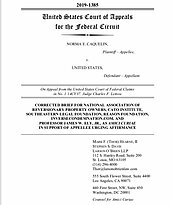Learn more about Cato’s Amicus Briefs Program.
Railroad lines once extended throughout the United States. At the peak in 1916, more than 270,000 miles of track crisscrossed the country. As railroads became less popular, however, thousands of miles of rail lines were left unused. Since the 1980s, the Rails-to-Trails Act has converted former rail lines into hiking and biking trails. But many of those rail lines were originally easements across private property. Under common-law doctrine, when an easement is abandoned and no longer used for the original purpose, the land “reverts” back to the property over which the easement was granted. Therefore, if the government wants to use part of an abandoned rail line for a trail, it needs to pay for the land under the Takings Clause of the Fifth Amendment.
Norma Caquelin’s great grandfather purchased a prime piece of Iowa farmland in 1892. Railroad tracks were placed on the land in 1870 and were part of the property when he purchased it. The farm was still in the family when the railroad company sought permission from the Surface Transportation Board (STB) to abandon the tracks. Under the Rails-to-Trails Act, after a railroad seeks permission to abandon tracks, potential trail developers can file a Notice of Interim Trail Use (NITU) to develop the tracks into a trail. After the railroad sought to abandon the tracks on Caquelin’s land, the city of Ackley and the Iowa National Heritage Foundation filed an NITU, which began a 180-day period of negotiations with the railroad to acquire the land. In the end, no deal was reached.
This case is about an abstract but important question: when does the government take land under the Rails-to-Trails Act? Is it when the NITU is filed or after the negotiation period ends? Since an agreement was never reached, the land was eventually abandoned and reverted back to Caquelin. But what about the 180-day period after an NITU is filed? Previously, the government has argued that the land is taken when an NITU is filed. In Ms. Caquelin’s case the judge in the lower courts awarded her $900 for that 180-day period. The government has now changed its mind, however, and rather than pay $900 they’re arguing that a taking only occurs after an agreement is reached. In rails-to-trails cases, landowners’ property is often tied up for years before a trail-use agreement is either executed or rejected. Therefore, if the government prevails in here, many owners’ land could be taken without compensation.
Cato has filed a brief in the Federal Circuit supporting Ms. Caquelin, and we’re joined by the National Association of Reversionary Property Owners, the Southeastern Legal Foundation, the Reason Foundation, and Professor James W. Ely. We argue that the original judgment awarding $900 to Ms. Caquelin was correct, and the government’s new theory is both a logical and practical disaster. Moreover, if the Court accepts the government’s theory, it will throw Trails Act jurisprudence into disarray—and there are a lot of these cases because there are a lot of unused railroad tracks. The court shouldn’t pay attention to the government’s change of mind, and it should maintain consistency and workability in Trails Act cases.

This work is licensed under a Creative Commons Attribution-NonCommercial-ShareAlike 4.0 International License.




